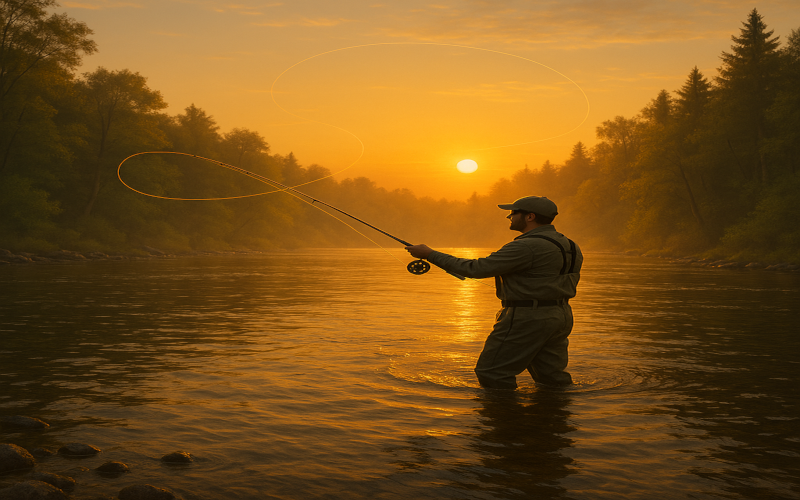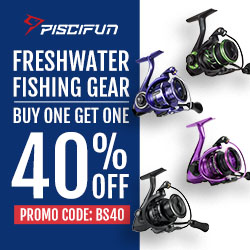Disclaimer: This post may have affiliate links. As an Amazon Associate, I earn from qualifying purchases.
Fly Fishing Fundamentals: Learning the Rhythm of the River
September 23, 2025 - Reading time: 6 minutes
Learn fly fishing basics including gear, casting techniques, and how to read the water. Discover why fly fishing is part art, part sport.

Fly fishing isn’t just another way to catch fish it’s a craft, a rhythm, and for many anglers, almost a meditation. Instead of relying on heavy lures or deep-diving crankbaits, fly fishing uses lightweight artificial flies to mimic insects resting on or drifting near the water’s surface. Done right, it’s as much about the art of presentation as it is about the catch.
If casting is the heartbeat of fishing, then fly fishing is its poetry.
Why Fly Fishing Is Different
Unlike conventional fishing, where the weight of the lure pulls line out, fly fishing uses the weight of the line itself to deliver a nearly weightless fly. This changes everything, the way you cast, the gear you use, and the places you fish.
Fly fishing shines in rivers and streams for trout, but it’s also gaining ground in warm-water lakes, saltwater flats, and even for bass.
Essential Fly Fishing Gear
-
Rod: Usually 7–9 feet, matched to line weight (#3–#8 depending on species).
-
Reel: Lightweight, smooth drag (not as critical as spin/baitcast reels).
-
Line: Fly line provides the casting weight; paired with backing and a leader.
-
Flies: Dry flies (float on top), nymphs (under the surface), and streamers (imitate small baitfish).
👉 BEST SELLER | 20% OFF BIG DEAL – This bestselling fly rod-and-reel kit is perfect for beginners looking to break into fly fishing without breaking the bank.
Casting: The Soul of Fly Fishing
The fly cast is different, it’s all about rhythm and timing, not brute force.
The Basic Overhead Cast:
-
Start with about 20 feet of line out.
-
Raise the rod tip smoothly to the 1 o’clock position.
-
Pause briefly to let the line unfurl behind you.
-
Push forward to the 10 o’clock position, letting the line roll out in front.
Pro Tip: Listen for your line, if you hear a “crack” like a whip, you’re rushing it. Slow down.
The Roll Cast:
-
Useful when you don’t have room to backcast.
-
Lift the line into a D-shape behind you and roll it forward onto the water.
Reading the Water
-
Eddies and Pools: Fish conserve energy in slow water while waiting for food.
-
Riffles: Oxygen-rich, great for trout feeding on drifting nymphs.
-
Undercuts: Shade and protection make these prime ambush spots.
Fly fishing is as much about observation as casting. Watch the insects, watch the current, and match your presentation.
Matching the Hatch
Fish eat what’s naturally available. Successful fly anglers study the insects around them and tie or choose flies that imitate them.
-
Morning: Nymphs often work best.
-
Afternoon: Dry flies shine when insects hatch.
-
Evening: Streamers mimic baitfish at dusk.
Pro Tips for Fly Fishing Success
-
Short Casts Win: Accuracy and presentation matter more than distance.
-
Stay Stealthy: Approach fish from downstream when possible.
-
Mend the Line: Lift and reposition line on the water to keep flies drifting naturally.
-
Practice on Grass: You can work on casting in your yard without water.
Common Fly Fishing Mistakes
-
Overpowering the cast (results in tangles).
-
Dragging the fly unnaturally with poor line control.
-
Ignoring insect life, fishing the wrong fly for the season.
Fly fishing is part technique, part patience, and part artistry. Once you feel the rhythm of the back-and-forth of the cast, the drift of the fly, the sudden strike of a trout and you’ll understand why it has captivated anglers for centuries.
And remember, starting with the right setup makes the journey easier:
👉 BEST SELLER | 20% OFF BIG DEAL
Hunting & Fishing Life - All-season outdoors living, guides, and gear reviews.
HookdLife - Outdoor stories, gear talk, and the hooked life culture.
Country Redneck - Country grit, humor, and real-life outdoor living.
Coffee & Grits - Southern mornings, hard work, and good coffee.
WolvesTale - Frontier tales and wilderness fiction inspired by the wild.
MTDLN Media Group - Explore our full outdoors and storytelling network.
